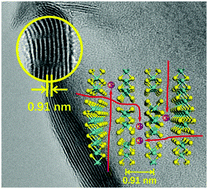当前位置:
X-MOL 学术
›
Nanoscale Horiz.
›
论文详情
Our official English website, www.x-mol.net, welcomes your
feedback! (Note: you will need to create a separate account there.)
Enhancing potassium-ion battery performance by defect and interlayer engineering†
Nanoscale Horizons ( IF 8.0 ) Pub Date : 2018-10-09 00:00:00 , DOI: 10.1039/c8nh00305j Yang Xu 1, 2, 3, 4, 5 , Farzaneh Bahmani 1, 2, 3, 4, 5 , Min Zhou 1, 2, 3, 4, 5 , Yueliang Li 5, 6, 7, 8, 9 , Chenglin Zhang 1, 2, 3, 4, 5 , Feng Liang 10, 11, 12, 13 , Sayed Habib Kazemi 14, 15, 16, 17 , Ute Kaiser 5, 6, 7, 8, 9 , Guowen Meng 13, 18, 19, 20 , Yong Lei 1, 2, 3, 4, 5
Nanoscale Horizons ( IF 8.0 ) Pub Date : 2018-10-09 00:00:00 , DOI: 10.1039/c8nh00305j Yang Xu 1, 2, 3, 4, 5 , Farzaneh Bahmani 1, 2, 3, 4, 5 , Min Zhou 1, 2, 3, 4, 5 , Yueliang Li 5, 6, 7, 8, 9 , Chenglin Zhang 1, 2, 3, 4, 5 , Feng Liang 10, 11, 12, 13 , Sayed Habib Kazemi 14, 15, 16, 17 , Ute Kaiser 5, 6, 7, 8, 9 , Guowen Meng 13, 18, 19, 20 , Yong Lei 1, 2, 3, 4, 5
Affiliation

|
Defect and interlayer engineering is applied to exploit the large van der Waals gaps of transition metal dichalcogenides for potassium-ion batteries (KIBs). As a demonstrator, MoS2 nanoflowers with expanded interlayer spacing and defects in the basal planes are used as KIB anodes in the voltage range of 0.5–2.5 V, where an intercalation reaction rather than a conversion reaction takes place to store K-ions in the van der Waals gaps. The nanoflowers show enhanced K-storage performance compared to the defect-free counterpart that has a pristine interlayer spacing. Kinetic analysis verifies that the K-ion diffusion coefficient and surface charge storage are both enhanced in the applied voltage range of the intercalation reaction. The collective effects of expanded interlayer spacing and additionally exposed edges induced by the in-plane defects enable facile K-ion intercalation, rapid K-ion transport and promoted surface K-ion adsorption simultaneously.
中文翻译:

通过缺陷和中间层工程提高钾离子电池的性能†
应用缺陷和夹层工程来开发用于钾离子电池(KIB)的过渡金属二卤化物的大范德华间隙。作为演示者,MoS 2在0.5-2.5 V的电压范围内,具有扩大的层间间距和基面缺陷的纳米花被用作KIB阳极,在此处发生嵌入反应而不是转化反应,以在范德华间隙中存储K离子。与具有原始中间层间距的无缺陷对应物相比,纳米花显示出增强的K存储性能。动力学分析证实,在插入反应的施加电压范围内,K离子扩散系数和表面电荷存储都得到了增强。扩大的层间间距以及由平面内缺陷引起的额外暴露边缘的集体效应使得能够同时进行便捷的K离子嵌入,快速的K离子传输和促进的表面K离子吸附。
更新日期:2018-10-09
中文翻译:

通过缺陷和中间层工程提高钾离子电池的性能†
应用缺陷和夹层工程来开发用于钾离子电池(KIB)的过渡金属二卤化物的大范德华间隙。作为演示者,MoS 2在0.5-2.5 V的电压范围内,具有扩大的层间间距和基面缺陷的纳米花被用作KIB阳极,在此处发生嵌入反应而不是转化反应,以在范德华间隙中存储K离子。与具有原始中间层间距的无缺陷对应物相比,纳米花显示出增强的K存储性能。动力学分析证实,在插入反应的施加电压范围内,K离子扩散系数和表面电荷存储都得到了增强。扩大的层间间距以及由平面内缺陷引起的额外暴露边缘的集体效应使得能够同时进行便捷的K离子嵌入,快速的K离子传输和促进的表面K离子吸附。











































 京公网安备 11010802027423号
京公网安备 11010802027423号